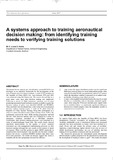- CERES Home
- →
- School of Engineering (SoE)
- →
- Staff publications (SoE)
- →
- View Item
JavaScript is disabled for your browser. Some features of this site may not work without it.
| dc.contributor.author | Li, Wen-Chin | - |
| dc.contributor.author | Harris, Don | - |
| dc.date.accessioned | 2014-01-25T05:01:10Z | |
| dc.date.available | 2014-01-25T05:01:10Z | |
| dc.date.issued | 2007-04-01T00:00:00Z | - |
| dc.identifier.citation | W.-C. Li and D. Harris, A systems approach to training aeronautical decision-making: From identifying training needs to verifying training solutions, The Aeronautical Journal, 2007, Volume 111, Issue 1118, Pages 267-279. | |
| dc.identifier.issn | 0001-9240 | - |
| dc.identifier.uri | http://dspace.lib.cranfield.ac.uk/handle/1826/8162 | |
| dc.description.abstract | The Human Factors Analysis and Classification System (HFACS) was developed as an analytical framework for the investigation of the role of human error in aviation accidents. Five hundred and twenty-three accidents in the Republic of China (R.O.C.) Air Force between 1978 and 2002 were analysed using this framework. The results showed that in a great many cases, poor pilot decision-making was implicated. Following a survey of flight instructors’ opinions, two of most promising mnemonic-based methods currently available to guide the decision-making of pilots were identified (SHOR and DESIDE). These methods were developed into a short (four hour) Aeronautical Decision Making Training course. Forty-one pilots from the Republic of China Tactical Training Wing then participated in a study to evaluate the effectiveness of this training course. Half of the participants received the short ADM training programme and half did not. Their decision-making skill was evaluated in a series of emergency situations presented in a full-flight simulator. Furthermore, their decision-making processes were examined in a series of pencil-and-paper based tests. The results clearly showed significant improvements in the quality of pilots’ situation assessment and risk management (underpinning processes in pilot decision making) although this was usually at the expense of speed of response. The results do strongly suggest, though, that ADM is trainable and the short programme devised was effective. | en_UK |
| dc.language.iso | en_UK | - |
| dc.publisher | Royal Aeronautical Society | en_UK |
| dc.subject | Aeronautical Decision-making, Evaluation, Human Errors, Human Factors Analysis and Classification Syatem, Training | en_UK |
| dc.title | A systems approach to training aeronautical decision-making: From identifying training needs to verifying training solutions | en_UK |
| dc.type | Article | - |
Files in this item
This item appears in the following Collection(s)
-
Staff publications (SoE) [603]
